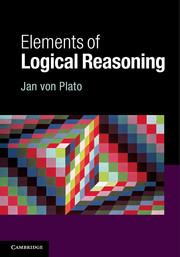Book contents
- Frontmatter
- Contents
- Preface
- PART I First steps in logical reasoning
- Part II Logical reasoning with the quantifiers
- Part III Beyond pure logic
- Part IV Complementary topics
- 13 Normalization and cut elimination
- 14 Deductive machinery from Aristotle to Heyting
- Suggestions for the use of this book
- Further reading
- Bibliography
- Index of names
- Index of subjects
13 - Normalization and cut elimination
Published online by Cambridge University Press: 05 June 2014
- Frontmatter
- Contents
- Preface
- PART I First steps in logical reasoning
- Part II Logical reasoning with the quantifiers
- Part III Beyond pure logic
- Part IV Complementary topics
- 13 Normalization and cut elimination
- 14 Deductive machinery from Aristotle to Heyting
- Suggestions for the use of this book
- Further reading
- Bibliography
- Index of names
- Index of subjects
Summary
Proofs by structural induction
(a) Inductive generation. Aclass of objectsissaidtobe inductively generated if, given some finite collection of objects and operations on objects, each object in the class is obtained from the finite collection after some bounded number of operations.
The importance of inductive generation is that it gives us a systematic means of proving properties of infinite collections of objects: The principle is to first prove that each object in the given finite collection has the property, then to prove that each way of generating new objects by the operations maintains the property.
The above abstract description is best illustrated by examples. The first and best-known inductive class is that of the natural numbers. The given finite collection is just the number 0, and there is a single operation, what is called the successor of a number n, the application of which is written s (n). The standard notation is 1 for s (0), 2 for s(s (0)), etc.
The principle of proof that goes with an inductive generation of the natural numbers is called arithmetic induction, or ‘complete induction’ in the older literature: Given a property of natural numbers, written A(n) for n, prove that 0 (or sometimes 1) has the property and that if n has the property, also s(n) has. In other words, prove A(0) and A(n) ⊃ A(s(n)). If n is arbitrary, the conclusion is that every natural number has the property.
- Type
- Chapter
- Information
- Elements of Logical Reasoning , pp. 195 - 219Publisher: Cambridge University PressPrint publication year: 2014



